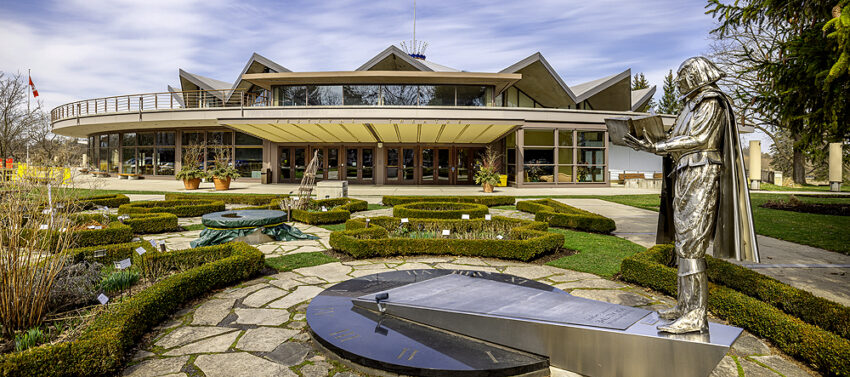This is another installment in Ibrahim Mustapha’s series of articles on the history of various communities in and around the Waterloo Region.
Stratford’s Early Days
Stratford’s story begins in 1832, nestled along the banks of the Avon River. Back then, it was a quiet area known as “Little Thames,” envisioned as the central marketplace for the vast Huron Tract in Southern Ontario. The Canada Company, a land development agency, spearheaded this initiative, attracting settlers with the promise of a thriving community.
The early years saw gradual growth. By 1834, a tavern, sawmill, and gristmill had sprung up, catering to the basic needs of the small population. A year later, a crucial milestone was reached with the establishment of a post office, officially christened “Stratford.” The name, a homage to Stratford-upon-Avon, the birthplace of William Shakespeare, hinted at the cultural aspirations that would blossom in the years to come.
Smith’s Canadian Gazetteer of 1846 paints a picture of a modest but self-sufficient community. With a population of around 200, Stratford boasted essential services like doctors, a general store, and blacksmiths. However, significant growth remained elusive until the arrival of the railways in the early 1850s.
The First Railway Developments
The “iron horse” acted as a catalyst for Stratford’s development. Local business leaders saw the potential of this new technology and lobbied for the creation of Perth County, with Stratford as its seat. Their efforts paid off, and Stratford became a key intersection point for three major railways. These connections transformed the town’s economy, with locomotive repair shops becoming major employers, providing jobs for a significant portion of the population (40% at its peak!).
While the railways fueled Stratford’s growth throughout the late 19th and early 20th centuries, a new industry was taking root – furniture manufacturing. Locally produced furniture gained recognition, contributing significantly to the city’s economic landscape.
However, history is rarely a smooth journey. The year 1933 witnessed a pivotal moment – a major strike by furniture workers. This labor dispute, led by the Communist Workers’ Unity League, became the last instance where the Canadian army intervened to quell a strike.
The End of an Era and the Beginnings of a New One
The arrival of diesel locomotives in the 1950s marked a turning point. As steam engines became obsolete, Stratford’s role as a major railway divisional point diminished, resulting in a significant job loss. This could have been a crippling blow, but the city demonstrated remarkable resilience.
Stratford’s leaders recognized the need for diversification. New industries were encouraged to establish themselves, preventing a complete reliance on a single sector. This proactive approach proved successful, with 19 manufacturing firms employing over 25 people each, and 21 exceeding 100 employees.
Interestingly, the city made a conscious effort to maintain a balance. Industrial development was strategically located on the outskirts, ensuring that the heart of Stratford, with its parks and commercial core, remained a vibrant and attractive space.
The Stratford Festival is Born
Despite the economic shifts, Stratford wasn’t about to lose its identity. In 1953, a cultural cornerstone was laid with the establishment of the Stratford Festival. This world-renowned theatre company transformed Stratford into a major tourist destination, attracting audiences from around the globe.
Stratford Timeline: A Journey Through Time
1828: The seeds of Stratford are sown as settlers begin arriving in the area.
1832: A pivotal year! An agent of the Canada Company christens the settlement “Stratford” and renames the local river the “Avon.” The first businesses, a sawmill, hotel (Shakespeare Hotel!), and gristmill, open their doors.
1834-1835: The community expands with the addition of a tavern and a crucial service – the first post office.
1849: Stratford gets its news! The Perth County News becomes the town’s first weekly newspaper.
1856: All aboard! The arrival of the Grand Trunk and Buffalo-Lake Huron railways transforms Stratford into a railway town.
1859: Stratford officially becomes a town.
1903: A gift for readers! The first public library opens its doors, thanks in part to financial assistance from American steel magnate Andrew Carnegie.
1908: The Stratford Normal School opened to train teachers, later renamed the Stratford Teachers’ College. This institution would go on to educate nearly 14,000 teachers before closing in 1973.
1909: The massive GTR (later CNR) locomotive repair shop building is completed.
1920s: Furniture takes center stage! Stratford has become a major furniture manufacturing center, with nearly one-sixth of all furniture in Canada coming from this city.
1953: A cultural milestone! The Stratford Shakespearean Festival Theatre opens its doors, forever changing Stratford’s identity.
1976: Recognition for a historic landmark! Stratford City Hall is designated a National Historic Site of Canada.
2003: The Stratford Festival celebrates a golden anniversary! They mark their 50th season with record attendance and the addition of new performance spaces.
Today, Stratford stands tall as a thriving city with a rich history. From its humble beginnings as a frontier settlement to its evolution as a center for industry and now a haven for the arts, Stratford’s story is one of adaptation, resilience, and a commitment to progress, all while preserving its unique character.

About The Author – Ibrahim Mustapha
Ibrahim crafts high-performance content that connects brands with their audiences and drives impactful results. He has extensive writing experience across various niches, including SaaS, Technology, Health, Nature, and Lifestyle. His track record of earning five-star ratings from clients serves as a proof of his unwavering commitment to excellence.

